
The moose or elk is the world's tallest, largest and heaviest extant species of deer and the only species in the genus Alces. It is also the tallest, and the second-largest, land animal in North America, falling short only of the American bison in body mass. Most adult male moose have broad, palmate antlers; other members of the deer family have pointed antlers with a dendritic ("twig-like") configuration. Moose inhabit the circumpolar boreal forests or temperate broadleaf and mixed forests of the Northern Hemisphere, thriving in cooler, temperate areas as well as subarctic climates.
The elk is a large antlered mammal within the deer family.

The Greater Yellowstone Ecosystem (GYE) is one of the last remaining large, nearly intact ecosystems in the northern temperate zone of the Earth. It is located within the northern Rocky Mountains, in areas of northwestern Wyoming, southwestern Montana, and eastern Idaho, and is about 22 million acres (89,000 km2). Yellowstone National Park and the Yellowstone Caldera 'hotspot' are within it.

The Irish elk, also called the giant deer or Irish deer, is an extinct species of deer in the genus Megaloceros and is one of the largest deer that ever lived. Its range extended across Eurasia during the Pleistocene, from Ireland to Lake Baikal in Siberia. The most recent remains of the species have been radiocarbon dated to about 7,700 years ago in western Russia. Its antlers, which can span 3.5 metres (11 ft) across are the largest known of any deer. It is not closely related to either living species called the elk, with it being widely agreed that its closest living relatives are fallow deer (Dama).
Neontology is a part of biology that, in contrast to paleontology, deals with living organisms. It is the study of extant taxa : taxa with members still alive, as opposed to (all) being extinct. For example:
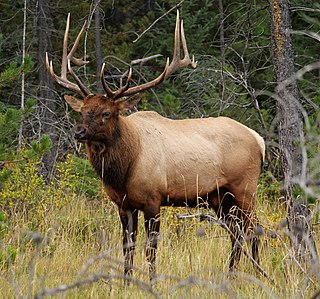
The elk, or wapiti, is the second largest species within the deer family, Cervidae, and one of the largest terrestrial mammals in its native range of North America and Central and East Asia. The word "elk" originally referred to the European variety of the moose, Alces alces, but was transferred to Cervus canadensis by North American colonists.
Venerable Macarius' Miracle of the Moose is a miracle associated with the name of Venerable Macarius of the Yellow Water Lake and the Unzha (1349-1444), a Saint of the Russian Orthodox Church. It is thought to have occurred in June 1439 in the woodlands of what today is Semyonov District of Nizhny Novgorod Oblast.
Alces is a peer-reviewed scientific journal that publishes original papers on the biology and management of moose throughout their circumpolar distribution, as well as other ungulate or carnivore species that overlap their range. It has been edited in published in Lakehead University since 1978. A single volume per year is published; a volume has one or sometimes two issues, with occasional supplements.
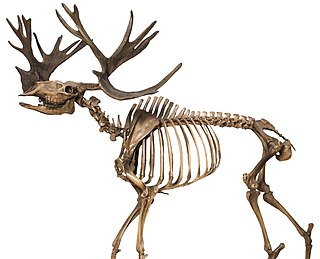
Cervalces scotti, also known as stag-moose, is an extinct species of large deer that lived in North America during the Late Pleistocene epoch. It is the only known North American member of the genus Cervalces. Its closest living relative is the modern moose.
Six species of deer are living wild in Great Britain: Scottish red deer, roe deer, fallow deer, sika deer, Reeves's muntjac, and Chinese water deer. Of those, Scottish red and roe deer are native and have lived in the isles throughout the Holocene. Fallow deer have been reintroduced twice, by the Romans and the Normans, after dying out in the last ice age. The other three are escaped or released alien species. Moose were also formerly native to Britain, before dying out during the mid-Holocene, over 5,000 years ago. The comparably sized Irish elk, which has the largest antlers of any deer was also formerly native to Britain until becoming extinct in region around 12,000 years ago.
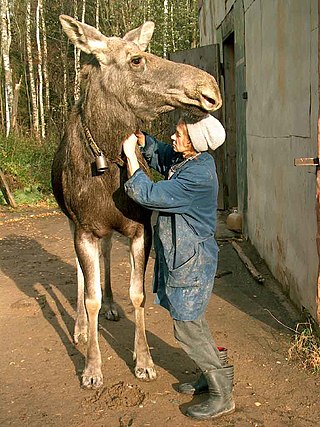
Moose milk, also known as elk milk, refers to milk produced by moose. Though it is most commonly consumed by moose calves, its production has also been commercialised in Russia, Sweden and Canada.
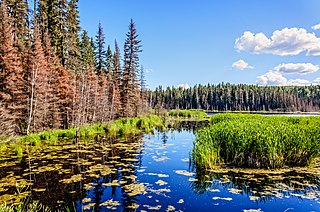
The Mid-Canada Boreal Plains Forests is a taiga ecoregion of Western Canada, designated by One Earth. It was previously defined as the Mid-Continental Canadian Forests by the World Wildlife Fund (WWF) categorization system, before it was modified by One Earth, the successor to WWF.

The Alaska moose, or Alaskan moose in Alaska, or giant moose and Yukon moose in Canada, is a subspecies of moose that ranges from Alaska to western Yukon. The Alaska moose is the largest subspecies of moose. Alaska moose inhabit boreal forests and mixed deciduous forests throughout most of Alaska and most of Western Yukon. Like all moose subspecies, the Alaska moose is usually solitary but sometimes will form small herds. Typically, they only come into contact with other moose for mating or competition for mates. Males and females select different home ranges during different seasons. This leads to spatial segregation throughout much of the year. While males and females are spatially separate the habitat that they occupy is not significantly different. During mating season, in autumn and winter, male Alaska moose become very aggressive and prone to attacking when startled.

The Western moose is a subspecies of moose that inhabits boreal forests and mixed deciduous forests in the Canadian Arctic, western Canadian provinces and a few western sections of the northern United States and it was introduced to New Zealand. It is the second largest North American subspecies of moose, second to the Alaskan moose. This subspecies is prey to timber wolves and bears. Male Western moose are aggressive during mating season and may injure or kill with provocation.

The eastern moose is a subspecies of moose that currently ranges throughout Eastern Canada, New England and northern New York State. It inhabits boreal forests and mixed deciduous forests. It is the third largest North American subspecies, after the western moose and the Alaskan moose. Males are aggressive during mating season and will attack anything that provokes them.

Cervalces latifrons, the broad-fronted moose, or the giant moose was a giant species of deer that inhabited the Europe and Asia during the Pleistocene epoch. It is thought to be the ancestor of the modern moose, as well as the extinct North American Cervalces scotti. It was considerably larger than living moose, placing it as one of the largest deer to have ever lived.
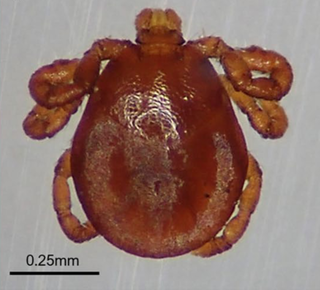
Dermacentor albipictus, the winter tick, is a species of hard tick that parasitizes many different mammal species in North America. It is commonly associated with cervid species such as elk, white-tailed deer, mule deer and caribou but is primarily known as a serious pest of moose. As early as 1909, Ernest Thompson Seton described the winter tick as a greater enemy of the moose than were "wolves, bears, and cougars."

Moose cavalry are military units of cavalrymen mounted on moose rather than the more usual horses. Some sources state that in 17th-century Sweden Charles XI trialled the use of moose as a replacement for horses, which had to be imported, but this is disputed. The use of moose cavalry by the Soviets in the Winter War of 1939 and 1940 is also reported but seems to stem from a 2010 Popular Mechanics April Fools' Day article.

The Big Elk, also known as Storelgen, is the world's second-tallest sculpture of an elk/moose. It is near the village of Atna in Stor-Elvdal, Innlandet, Norway. It held the title of the tallest moose sculpture for 4 years, from its completion in October 2015 until October 2019.
Gravel River Provincial Park is a nature reserve in the Thunder Bay District of Ontario, Canada. It protects an unusual birds-foot delta at the mouth of the Gravel River.













